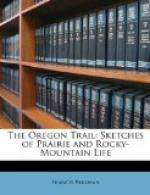to the horizon; on our right, a deep gulf, with Laramie
Creek at the bottom. We found ourselves at length
at the edge of a steep descent; a narrow valley, with
long rank grass and scattered trees stretching before
us for a mile or more along the course of the stream.
Reaching the farther end, we stopped and encamped.
An old huge cotton-wood tree spread its branches horizontally
over our tent. Laramie Creek, circling before
our camp, half inclosed us; it swept along the bottom
of a line of tall white cliffs that looked down on
us from the farther bank. There were dense copses
on our right; the cliffs, too, were half hidden by
shrubbery, though behind us a few cotton-wood trees,
dotting the green prairie, alone impeded the view,
and friend or enemy could be discerned in that direction
at a mile’s distance. Here we resolved
to remain and await the arrival of The Whirlwind, who
would certainly pass this way in his progress toward
La Bonte’s Camp. To go in search of him
was not expedient, both on account of the broken and
impracticable nature of the country and the uncertainty
of his position and movements; besides, our horses
were almost worn out, and I was in no condition to
travel. We had good grass, good water, tolerable
fish from the stream, and plenty of smaller game,
such as antelope and deer, though no buffalo.
There was one little drawback to our satisfaction—a
certain extensive tract of bushes and dried grass,
just behind us, which it was by no means advisable
to enter, since it sheltered a numerous brood of rattlesnakes.
Henry Chatillon again dispatched The Horse to the
village, with a message to his squaw that she and her
relatives should leave the rest and push on as rapidly
as possible to our camp.
Our daily routine soon became as regular as that of
a well-ordered household. The weather-beaten
old tree was in the center; our rifles generally rested
against its vast trunk, and our saddles were flung
on the ground around it; its distorted roots were
so twisted as to form one or two convenient arm-chairs,
where we could sit in the shade and read or smoke;
but meal-times became, on the whole, the most interesting
hours of the day, and a bountiful provision was made
for them. An antelope or a deer usually swung
from a stout bough, and haunches were suspended against
the trunk. That camp is daguerreotyped on my memory;
the old tree, the white tent, with Shaw sleeping in
the shadow of it, and Reynal’s miserable lodge
close by the bank of the stream. It was a wretched
oven-shaped structure, made of begrimed and tattered
buffalo hides stretched over a frame of poles; one
side was open, and at the side of the opening hung
the powder horn and bullet pouch of the owner, together
with his long red pipe, and a rich quiver of otterskin,
with a bow and arrows; for Reynal, an Indian in most
things but color, chose to hunt buffalo with these
primitive weapons. In the darkness of this cavern-like
habitation, might be discerned Madame Margot, her overgrown




